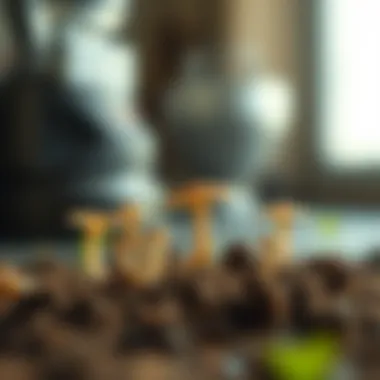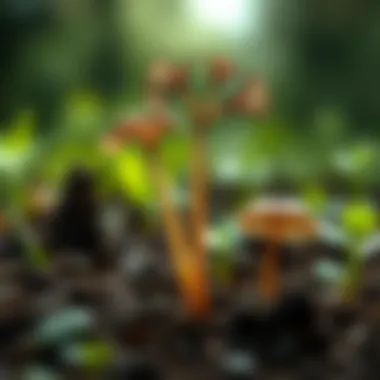Soil Testing Methods for Fungal Detection


Intro
Understanding the intricate world of fungi is valuable for both ecological stability and agricultural productivity. Fungi play a vital role in soil health, contributing to nutrient cycling, organic matter decomposition, and the formation of symbiotic relationships with plants. However, not all fungi are beneficial; some can be pathogenic, adversely affecting crop yield and soil quality. Therefore, accurately assessing the presence of fungi in soil is essential for making informed land management decisions.
This article delves into various methodologies for assessing fungal presence in soil samples. The aim is not just to present techniques that are scientifically sound but also to equip readers with the knowledge necessary to interpret results meaningfully. With an array of methods available, understanding the right approach is crucial in addressing specific agricultural and ecological contexts.
Methodology
Study Design
Designing a robust study for assessing fungi in soil requires careful planning. The objectives of the study often determine the chosen methodologies. For comprehensive analysis, field studies combined with laboratory tests are generally employed. Field samples should be taken from various sites. These samples provide an overview of fungal diversity and potential contamination levels. Variables such as soil type, moisture content, and temperature should be recorded, as they significantly influence fungal activity in soil.
Data Collection Techniques
When it comes to data collection for assessing fungal presence, several techniques stand out:
- Visual Inspection: Initial assessment might start with visual changes in soil such as discoloration or unusual odors, hinting at fungal growth.
- Soil Sampling: Using sterile tools, collect soil samples from various depths and locations. A GPS device could help in mapping sample locations for further studies.
- Culture Techniques: In a lab, soil samples can be cultured on selective agar media. This method allows for the isolation of specific fungal taxa, enabling the researcher to identify pathogenic or beneficial species with more precision.
- Molecular Methods: Techniques such as Polymerase Chain Reaction (PCR) are gaining traction. They allow for the detection of fungal DNA, proving particularly useful for identifying species that may not grow well in culture.
- Soil Respiration Measurements: Monitoring CO2 emissions from soil can provide insights into fungal activity, as higher levels may indicate active decomposition.
Fungi serve critical roles in ecosystems, yet some varieties can disrupt agricultural productivity. Employing multiple testing methodologies can give a clearer picture of soil health.
Discussion
Interpretation of Results
Results from fungal assessment can yield a wealth of information about soil health. Culturing and molecular methods can identify species composition and abundance, while soil respiration data can indicate overall microbial activity. It is critical to integrate these findings with the environmental variables documented during the study. Analyzing patterns helps in determining whether the fungal presence is beneficial or harmful to the soil ecosystem.
Limitations of the Study
Every methodology comes with its set of limitations. For instance, culturing techniques might overlook certain species, especially those that are hard to cultivate in a lab. Furthermore, soil heterogeneity can introduce variability in results, making it challenging to draw definitive conclusions from a limited number of samples. While molecular methods are precise, they can be costly and require specialized equipment and expertise.
Future Research Directions
Ongoing advancements in technology and methodology offer promising avenues for future research. Exploring the symbiotic relationships between fungi and plant roots through new imaging techniques could uncover beneficial interactions previously unnoticed. Additionally, leveraging artificial intelligence for analyzing large datasets can refine our understanding of soil fungi’s role across different ecosystems.
Understanding Soil Fungal Dynamics
Grasping the intricate dynamics of soil fungi is crucial for various reasons, primarily their role in ecosystem health and agricultural productivity. Fungi are not just simple entities that colonize soil; they’re complex organisms that engage in a multitude of activities affecting nutrients, plant health, and overall soil structure. Recognizing these dynamics allows for better management choices in both farming and conservation practices.
Healthy soils are the backbone of robust ecosystems, and fungi are key players in maintaining that health. They engage in processes like nutrient cycling, which makes them indispensable, particularly in nutrient-poor soils. Their presence indicates a thriving ecosystem ready to support plant life, whereas a lack of fungi can suggest degraded or unhealthy soil conditions—thus, evaluating fungal dynamics not only aids in understanding soil health but also informs effective remediation strategies that can be implemented.
Importance of Fungi in Soil Ecosystems
Fungi serve several essential functions in soil ecosystems. One vital role is their contribution to nutrient cycling. By breaking down organic matter, fungi release nutrients back into the soil, making them available for plant uptake. This is particularly important in agricultural settings, where nutrient availability can optimize crop yields. Furthermore, fungi enhance soil structure by forming aggregates that improve aeration and water retention—traits crucial for sustaining plant growth.
Another significant aspect is the symbiotic relationships fungi establish with plants. Mycorrhizal fungi, for instance, form connections with plant roots, facilitating nutrient exchange. This is a win-win situation: while plants receive critical nutrients, fungi gain access to carbohydrates produced through photosynthesis. Such relationships underscore the symbiotic nature of these organisms, emphasizing their importance in both natural and managed ecosystems.
Types of Soil Fungi
Soil fungi can be categorized broadly, leading to an even deeper understanding of their distinct roles and functionalities in capably assessing soil health. Recognizing these categories helps in determining the best methods for assessing fungal presence in the soil and better understanding the implications of their presence. Below, we examine the three main types of soil fungi: decomposers, mycorrhizal fungi, and pathogenic fungi.
Decomposers
Decomposers are one of the primary types of fungi found in the soil. Their significance cannot be overstated, as they play a pivotal role in breaking down dead organic material. This decomposition process not only recycles nutrients but also helps in maintaining soil fertility. The key characteristic of decomposers is their ability to thrive on complex organic substances, like fallen leaves and dead organisms, converting them into simpler compounds.
A unique feature of decomposers is their enzymatic arsenal; they produce a range of enzymes that can digest cellulose, lignin, and other tough materials. This aspect is beneficial for soil health, as it aids in enhancing soil structure and fertility over time. However, a downside can arise with an overabundance of certain decomposing fungi, which might lead to accelerated decay, potentially impacting the soil's nutrient balance negatively.
Mycorrhizal Fungi
Mycorrhizal fungi form one of the most symbiotic relationships with plants. Their association facilitates the transfer of water and essential nutrients like phosphorus from the soil to plant roots, while also assisting in root growth and health. The key characteristic of mycorrhizal fungi is the formation of hyphal networks, which allow a plant to access a larger volume of soil. This relationship leads to improved plant resistance against pathogens and stress conditions.
A unique feature of mycorrhizal fungi is their diversity, comprising multiple species that vary in their functional roles. This diversity is advantageous as it allows for more robust nutrient acquisition strategies for plants. However, the relationship can depend on soil conditions and the presence of other microorganisms, which can sometimes lead to complications if not well understood.
Pathogenic Fungi
Pathogenic fungi are perhaps the most complex of the three types. Unlike decomposers and mycorrhizal fungi that contribute positively to soil health, pathogenic fungi can severely impact plant health by causing diseases. The key characteristic of pathogenic fungi is their ability to invade living tissue, extracting nutrients at the host's expense. This characteristic poses significant risk to agricultural systems, where crops can suffer substantial yield losses.
A unique feature of pathogenic fungi is their adaptability; they can often evolve rapidly to overcome plant defenses. While this can be a disadvantage for crops, it serves as a point of interest for researchers focusing on disease resistance in plants. Understanding pathogenic fungi is essential in the context of fungal presence assessment, to differentiate between harmful and beneficial fungi, thus underscoring their dual nature in soil ecosystems.
Symptoms of Fungal Contamination
Recognizing the signs of fungal contamination in soil is crucial for any environmental or agricultural enthusiast. These symptoms can serve as early warning signals, allowing for prompt intervention before significant damage occurs. Understanding these indicators not only aids in assessing soil health but also provides insight into the ecosystem's overall balance. Moreover, detecting fungal presence enables practitioners to implement preventative measures, ensuring sustainable soil management and crop productivity.
Visual Indicators
Visual clues can be the first sign of fungal contamination in soil. These indicators often require careful observation and may include various phenomena that can easily be overlooked.
Mold Growth
Mold growth is perhaps the most noticeable visual indicator. This phenomenon can manifest as a fuzzy or web-like layer covering soil surfaces or decaying organic matter. Mold thrives in damp conditions, contributing to its prominence in overly saturated soils. Its presence often means that the soil is hospitable to fungal activity, which can be a signal for bioremediation efforts. However, too much mold can indicate a slight imbalance in the ecosystem, as some species may compete with beneficial microbes.
Key Characteristics: Mold varies in color – from white to green or black – which can add complexity when identifying specific strains.


Unique Features: Mold growth can indicate the decomposition process is active, recycling nutrients back into the soil, but excessive mold may hinder plant growth and lead to disease.
Color Changes in Soil
Alterations in soil color can also signal the presence of fungi. Changes from a rich brown or black to a pale or ashy color may indicate fungal dominance. These shifts occur due to various factors, such as the breakdown of organic materials or the binding process of fungi with soil particles, which can affect aeration and drainage.
Key Characteristics: A color change is often a gradual process and might be more noticeable in areas receiving limited light.
Unique Features: While some color changes can indicate healthy fungal activity, dramatic shifts could suggest detrimental fungal proliferation, warranting further investigation.
Plant Health Decline
Declining plant health is another noticeable symptom of potential fungal issues. This may manifest as wilting, yellowing leaves, or stunted growth, often due to root infections caused by pathogenic fungi. Plants unable to uptake necessary nutrients and water are particularly susceptible to fungal damage.
Key Characteristics: Affected plants will typically show signs of distress, even if other surrounding flora appear healthy.
Unique Features: The decline in plant health serves as a critical alarm for soil evaluation. This can lead to corrective measures, informing land management practices and enhancing soil resilience.
Subtle Signs
Beyond the evident visual indicators, subtle signs of fungal contamination may remain hidden unless actively searched for. Being attuned to these hints can significantly benefit soil assessment efforts.
Odors
Unusual odors emanating from the soil can hint at significant fungal presence. Fungal activities can produce various volatile compounds that alter the smell of the soil, which might be reminiscent of mushrooms or earthy scents. While some odors are benign, others can signal decay or rot, indicating an imbalance between beneficial and harmful organisms.
Key Characteristics: A strong and persistent smell is usually more concerning than mild, fleeting odors.
Unique Features: The characteristic smells attributable to specific fungi can allow for preliminary identification, guiding what further tests may be necessary.
Soil Texture Alterations
Changes in soil texture may also indicate fungal activity. Fungi contribute to soil aggregates through hyphal networks, which can either enhance structure or lead to compaction if unchecked. A significant alteration might present as soil becoming both overly loose or exceedingly hard, making it challenging for roots to penetrate or flourish.
Key Characteristics: If soil texture noticeably differs in areas with visible fungal activity, this might warrant further assessment.
Unique Features: Soil texture change provides insight into the overall health and structure of the soil ecosystem, suggesting areas where intervention could be beneficial.
"Noticing the symptoms of fungal contamination early can prevent further soil degradation and protect plant health, creating a more resilient ecosystem overall."
In summary, visual indicators and subtle signs of fungal contamination are fundamental in deciding the next steps for soil assessment and management. Properly interpreting these symptoms assists agricultural practitioners and environmentalists in nurturing healthier environments.
Preparation for Soil Testing
Preparing to assess soil for fungi is a pivotal process that can greatly influence the accuracy and effectiveness of the testing results. By laying a solid groundwork through proper preparation, one can ensure that subsequent analyses are not only reliable but also relevant to the specific context in which the soil will be used. This preparation involves careful selection of soil samples, adequate equipment, and consideration of safety practices. Each of these elements contributes to understanding the soil's health and potential fungal contamination levels, which are crucial for both agricultural and ecological purposes.
Selecting Soil Samples
Sampling Depth
Sampling depth is a critical factor that can define the outcome of soil testing. Ideally, one should aim for a depth that captures the variation in soil profiles, typically around 6 to 12 inches when dealing with standard agricultural soils. This depth is beneficial because it encompasses a zone where most biological activity occurs. One unique feature of this depth is its ability to reflect both surface and subsurface conditions, providing a more comprehensive picture of fungal presence.
However, an important disadvantage to consider is that deeper sampling can become physically demanding, and there is a risk of disturbing stratified layers. If deeper layers are not homogenous, sampling too deep may skew the results, leading one astray.
Site Selection Criteria
Choosing where exactly to take samples can turn out to be as important as the act of sampling itself. There are numerous criteria one should consider, such as soil type, land use practices, and historical records of fungal issues in the area. The selected site should have good representation of the target field. A key characteristic of thoughtful site selection is its role in ensuring that the data collected reflects typical soil conditions rather than anomalies.
On the flip side, a disadvantage of strict site selection might limit a comprehensive picture, particularly if a single site does not represent broader environmental conditions. Sampling from multiple sites can mitigate this risk but requires more time and resources.
Timing of Sampling
Timing can significantly impact soil testing outcomes, especially for fungi. Optimal sampling times generally align with the growing season when fungal activity is at its peak, usually in the moist conditions of spring or early summer. This strategic timing helps in capturing a true representation of fungal dynamics. A unique feature here is that timing can vary significantly based on climatic conditions, necessitating a localized approach to determine the best sampling window.
One downside, however, is that delayed sampling until peak activity can lead to waiting longer than necessary for test results. This may postpone any required mitigation strategies or exacerbate other soil health issues.
Equipment and Materials Needed
Shovels and Trowels
When it comes to digging up soil samples, shovels and trowels are indispensable tools. Shovels assist in larger sample collection, particularly when you need volume, while trowels offer precision for deeper, specific collections. Their versatility makes them a popular choice among soil testers as they can navigate different soil textures with ease. A key aspect of using shovels and trowels is the ability to quickly collect samples from multiple depths or locations. However, a drawback lies in the skill required to use these tools efficiently; improper technique can lead to poorly collected samples tainted by cross-contamination from other soil layers.
Sample Containers
Appropriate sample containers are essential for preserving the integrity of collected soil. Often, sterile glass jars or polyethylene bags are used to store soil samples, which prevent contamination and maintain moisture levels. A key characteristic to note is that these containers need to be labeled correctly to keep track of their origins. Using high-quality containers ensures that the sample will remain viable for later analysis, which is beneficial in studies requiring serial testing. However, poor sealing or inappropriate materials can lead to sample degradation, undermining the whole testing process.
Personal Protective Equipment
Finally, using personal protective equipment (PPE) during soil sampling cannot be overlooked. Equipment like gloves, masks, and protective eyewear is crucial to safeguard against potential pathogens or chemicals that may be present in contaminated soil. A critical aspect of wearing PPE is its role in preventing exposure to harmful substances, ensuring the safety of the individual conducting the tests. The unique feature of proper PPE use is that it not only protects the tester but also preserves the samples from potential disturbance by human contaminants. Nevertheless, it may also limit dexterity in handling tools, which could complicate the sampling process.
Techniques for Testing Soil for Fungi
Testing soil for fungal presence is more than just a scientific endeavor; it's essential for maintaining healthy ecosystems and ensuring sustainable agricultural practices. Understanding the methods used to assess fungi in soil allows for better management of crops, protection of biodiversity, and prevention of the spread of pathogenic species. Each technique offers unique insights and benefits, presenting a holistic overview of fungal dynamics in the environment.


Visual Examination
A visual examination serves as the first line of defense in assessing soil health concerning fungal presence. This technique involves a careful observational assessment of soil samples for any noticeable signs of fungal activity. This might include noting changes in color, the appearance of mold, or unusual growths.
The merits of visual examination lie in its simplicity. It requires minimal equipment and can often be done in the field, allowing for immediate feedback. However, it requires a trained eye to spot potential indicators, and its effectiveness can be limited by certain conditions. Moreover, visual signs may not always correlate with harmful fungal species, so it’s essential to combine this method with more advanced techniques.
Moisture Content Assessment
Moisture content in soil is a critical factor influencing fungal growth. A moisture content assessment involves measuring the amount of water present in the soil, as different fungi thrive in varying moisture levels. Generally, fungi prefer damp conditions, making this assessment vital for determining the likelihood of fungal proliferation.
Tools such as soil moisture sensors or gravimetric methods can help quantify moisture content. The assessment indicates where conditions might favor pathogen development, guiding when and how to implement management strategies. Keep in mind that while moisture assessment can highlight potential issues, it does not specifically identify types of fungi present.
Laboratory Culturing Methods
Culturing soil samples in a laboratory setting presents a more definitive way to identify the presence of fungi. This method allows researchers to grow fungal colonies under controlled conditions, making it easier to observe their characteristics and behaviors.
Use of Agar Plates
Agar plates play a pivotal role in laboratory culturing methods. The use of agar plates allows for the cultivation of fungi in a medium that supports their growth while inhibiting competing organisms. The key characteristic is that agar is versatile; it can be tailored with various nutrients to cater to specific fungal needs, making it an impactful choice for isolating individual species.
One of the unique features of agar plates is their ability to provide visual evidence of fungal colonies, making it straightforward to identify size, color, and texture differences among various fungi. However, limitations exist, such as the requirement of sterile conditions and potential selectivity bias that can obscure the full spectrum of fungi present in natural samples.
Selective Media Techniques
Selective media techniques build upon the principles of agar plates by incorporating specific ingredients that favor particular fungi while suppressing others. This method can significantly enhance the likelihood of isolating the fungi of interest.
The main characteristic of selective media is its targeted design, making it popular for identifying pathogenic fungi that could pose risks to plant health. A unique aspect of selective media is its capacity to yield high-resolution data on fungal species, thereby informing management practices. However, the downside includes the possibility of overlooking non-target fungi that also play essential roles in the ecosystem.
Molecular Techniques
Molecular techniques have redefined the methods for testing soil fungi. These advanced techniques enable not only the identification but also the characterization of fungi at a genetic level.
DNA Sequencing
DNA sequencing is a cornerstone of modern fungal identification. This technique involves extracting and analyzing genetic material from soil samples, leading to precise identification of fungal species, even those that are hard to culture.
The standout feature of DNA sequencing lies in its accuracy and speed, making it beneficial for identifying diverse fungal taxa. With the ability to process samples rapidly, it provides a comprehensive overview of the fungal diversity present, paving the way for informed ecological management. However, costs and technical expertise can be barriers to its widespread application.
Polymerase Chain Reaction
Polymerase Chain Reaction (PCR) amplifies segments of DNA, allowing for the detection of specific fungal species in soil samples. This method is particularly advantageous when fungi are present in low abundance.
The crucial characteristic of PCR is its sensitivity in detecting minute quantities of DNA, which can be invaluable when dealing with pathogenic fungi. The ability to target specific genetic markers makes it a powerful tool for identifying specific pathogens and studying their distribution in soil. On the flip side, PCR requires proficiency in molecular biology techniques and may necessitate more expensive equipment.
Through these diverse techniques, soil scientists and researchers can holistically understand fungal presence and dynamics, guiding both agricultural practices and ecological interventions.
Effective soil testing is more than a routine check-up; it's an indispensable part of maintaining ecosystem balance.
Interpreting Test Results
When it comes to assessing soil for fungal presence, interpreting the results from various tests is a pivotal step that dictates not only understanding but also subsequent actions. A proper interpretation helps in recognizing the health status of the soil and deciding on future management strategies. Without these insights, one could be flying blind in an often unpredictable ecosystem.
Understanding Fungal Biodiversity Metrics
At the heart of fungal assessment lies an appreciation for biodiversity metrics. Biological diversity in the soil isn't just an abundance of fungi; it's about the varieties that reside within that realm. These metrics evaluate the number of different fungal species present, as well as their respective abundances.
Why is this important? A rich fungal diversity often indicates a healthy soil ecosystem, supporting plant growth and nutrient cycling. Conversely, a low diversity could underscore an imbalance, suggesting degradation or contamination. Checking on fungal metrics allows researchers and practitioners to ascertain whether their methods of soil management are hinging on health or deterioration.
- Simple metrics include:
- Species richness (number of different species)
- Shannon-Wiener diversity index (an index reflecting species diversity)
An informed interpretation of these metrics can lay the groundwork for effective soil stewardship and management decisions, guiding actions that could enhance soil biodiversity.
Identifying Potential Issues
Navigating through the complexities of soil fungi also includes spotting potential problems. Some fungi are beneficial—helping in root interactions and nutrient acquisition—while others can bring about various forms of plant disease. Recognizing the differences is crucial.
Pathogenic vs. Beneficial Fungi
Pathogenic fungi can wreak havoc, generating disease in plants by attacking roots and stems. For example, Fusarium species typically cause root rot in crops. Conversely, beneficial fungi, such as mycorrhizal species, play a major role in enhancing plant nutrition and resilience. They extend the root system, increasing the uptake of water and nutrients.
- Key Characteristics:
- Pathogenic fungi typically reproduce more rapidly and adapt quickly to host plants.
- Beneficial fungi form symbiotic relationships with plant roots, strengthening plant health.
The key characteristic of pathogenic fungi makes them a relevant consideration in this article as their presence often correlates with decreasing soil health. Their unique ability to thrive in stressed environments, combined with their rapid reproduction can lead to massive crop losses. When interpreting tests, it’s essential to categorize isolated fungi, ensuring that the beneficial types are abundant to counterpose potential pathogenic threats.
Implications for Soil Health
The health of soil heavily rests on fungal composition. Recognizing both pathogenic and beneficial fungi leads to making informed decisions about soil management. If pathogenic fungi dominate, soil health could be at risk, revealing an unhappy ecosystem.
- Unique Features:


- High pathogenic fungus levels may indicate waterlogged conditions or lack of crop rotation.
- Conversely, thriving beneficial fungi suggest a nutrient-rich, well-balanced soil environment.
By understanding these dynamics, one can assess how treatments and changes impact overall soil health. This section's focus on implications provides clarity to interrelated aspects of soil productivity, sustainability, and ecological balance approaches.
Rather than viewing fungi purely as adversaries or allies, it is essential to regard them as part of a larger tapestry influencing soil health.
Mitigation Strategies for Fungal Contamination
Mitigation strategies for fungal contamination play a critical role in maintaining soil health and ensuring productive agricultural practices. This section delves into the practices that can reduce the prevalence of detrimental fungi in the soil while fostering a healthy environment for beneficial organisms. Understanding these strategies equips farmers, researchers, and environmentalists to make informed choices that promote sustainable land use and ecological balance.
Cultural Practices
Crop Rotation
Crop rotation is an agricultural practice that involves alternating the types of crops grown in a particular area over a sequence of seasons. This method is crucial for breaking the life cycles of existing fungal pathogens in the soil. By changing crops, the specific nutritional and environmental conditions that some fungi thrive on are disrupted.
A key characteristic of crop rotation is its ability to enhance soil structure and fertility while limiting disease. It’s a beneficial choice because it reduces the dependency on chemical fertilizers and enhances biodiversity. Rotating crops such as grains, legumes, and brassicas can curtail the build-up of pathogens, resulting in healthier soil. Conversely, its drawback might be the initial costs and planning required to implement such rotations effectively; farmers need to balance between short-term yields and long-term benefits.
Improving Drainage
Improving drainage systems in agricultural fields is another vital method for mitigating fungal contamination. Fungi often flourish in waterlogged soils where they can thrive on the excess moisture. Adapting field drainage can radically change the soil’s water regime, thus creating unfavorable conditions for many pathogenic fungi.
A significant aspect of this strategy is that enhancing drainage helps prevent soil erosion and maintains structural integrity. Its popularity stems from the immediate improvement of soil conditions, which can lead to increased crop yield and quality. However, there are challenges in terms of cost and ongoing maintenance, as poorly designed drainage systems can lead to other environmental issues, such as nutrient loss and impact on local ecosystems.
Biological Control
Use of Antifungal Microorganisms
Utilizing antifungal microorganisms emphasizes harnessing nature's inherent mechanisms to combat harmful fungi. Applying species like Trichoderma or Bacillus can effectively suppress soil-borne pathogens through competition and parasitism. Their role is pivotal, as they can prevent the establishment of pathogenic fungi, promoting a healthier microbial balance.
The key feature of using antifungal microorganisms lies in their sustainability; they are environmentally friendly alternatives to chemically synthesized fungicides. Their popularity stems from the rise in organic farming where reliance on synthetic inputs is discouraged. Nonetheless, one must consider that their effectiveness can vary depending on the specific conditions and interactions within the soil microbiome.
Enhancing Beneficial Fungi
Enhancing beneficial fungi is another crucial aspect of infection prevention strategies. These organisms can outcompete harmful fungi for resources, ensuring that pathways for growth remain fortified against invasion. Mycorrhizal fungi, for instance, can form symbiotic relationships with plants, enhancing nutrient uptake while improving plant resilience to various soilborne diseases.
The unique aspect of fostering beneficial fungi is that it often requires less intervention than chemical control measures. This makes it a beneficial and sustainable strategy within a holistic approach to soil management. However, the downside could lie in the time needed for populations to establish and exert their beneficial effects on the ecosystem.
Chemical Interventions
Fungicides
Fungicides represent a more traditional method of combating fungal contamination in the soil. These chemicals are designed to incapacitate or kill fungal organisms, and they have been a mainstay in agricultural practice for decades. The primary feature of fungicides is their speed of action in controlling fungal populations, which can be crucial during outbreaks.
While fungicides can offer immediate relief and are a popular choice for quick fixes, the long-term implications cannot be overlooked. Overreliance can lead to resistance development among fungal populations and potential harm to non-target organisms. Furthermore, the residue left behind can pose health risks or environmental concerns, which need careful consideration in their application.
Application Timing and Dosage
The timing and dosage of fungicide application greatly influence the effectiveness and safety of chemical interventions. Applying fungicides at the optimal phase of fungal development ensures that the target organisms are most vulnerable and enhances control efficiency.
Adhering to recommended guidelines for dose is vital; too little might fail to control the fungi, while excessive application could lead to toxic buildup in the soil. This careful calibration makes it a beneficial strategy but necessitates monitoring for efficacy and safety, complicating its ease of use. Among its downsides are potential miscalculations and the need for constant evaluation to determine the optimal treatment schedule.
Takeaway: Balancing these strategies is key to effective soil management. Each approach—cultural, biological, or chemical—carries its strengths and weaknesses. Determining the right combination based on specific needs and local conditions is essential for sustainable soil health and agricultural prosperity.
Future Research Directions
The realm of soil health is an ever-evolving field, especially when it comes to understanding soil fungal presence. Gaining insight into fungi’s role in soil ecosystems is not just valuable; it's crucial. As we move forward, several specific elements should be at the forefront of research, which can create a ripple effect in agricultural practices and ecological understanding. By honing in on these areas, we can pave the way for innovative solutions and deeper comprehension of soil dynamics.
Innovations in Soil Testing
One significant area for future research revolves around innovations in soil testing methods. Traditional methods may provide insights, but they often lack the sensitivity needed to detect varying densities of fungal populations.
- Remote Sensing Technologies: Advancements in drone technology and satellite imagery could allow for large-scale soil assessments without needing extensive ground sampling. These technologies can offer a holistic view of fungal distributions and soil health on a farm or ecological reserve.
- Microfluidic Devices: These small-scale labs could facilitate instant analysis of soil samples, enabling timely detection of fungal contaminants for more immediate interventions. They have the potential to streamline workflows and reduce costs associated with lab testing.
- Real-time Monitoring Sensors: Deploying sensors that provide real-time data on moisture levels, temperature, and soil pH can help predict fungal outbreaks based on environmental shifts. Integrating this data can lead to proactive measures and more effective management strategies.
Most importantly, ongoing development in these innovations can sharpen our assessment techniques, making them applicable in diverse contexts, from urban gardening to large-scale agriculture.
Understanding Fungal Ecology
The second pillar of future research is understanding fungal ecology. It's not simply sufficient to detect the presence of fungi within soil; we must grasp the broader ecological implications and interactions.
- Fungal Interactions with Flora and Fauna: Research can explore how different types of fungi symbiotically relate with plants. For instance, studying mycorrhizal associations in various plant species may lead to agriculture practices that naturally enhance crop yields and resilience.
- Impact of Environmental Changes: As climate change alters ecosystems, understanding how fungi adapt and respond to these shifts is critical. Assessing their survival strategies can offer insights into the health of our soils in changing climates.
- Fungi in Bioremediation: Exploring the potential of fungi to break down pollutants, like heavy metals or petroleum products, can lead to more sustainable practices in contaminated land management.
Ultimately, digging deeper into these aspects not only unravels the complexities of soil health but also guides practices toward fostering resilient ecosystems. As we enhance our understanding of fungal presence and its implications, the path forward will be marked by more informed, effective approaches to soil stewardship.
"As the soil grows richer with fungi, so too does our understanding of its health and vitality."
Epilogue
In the ever-evolving field of soil science, assessing fungal presence stands as a significant component of understanding soil health. The implications of soil fungi span far beyond mere biodiversity; they play critical roles in ecosystem functionality, nutrient cycling, and plant health. As we’ve discussed, the various methods—ranging from visual examinations to advanced molecular techniques—offer researchers and practitioners alike a toolkit for evaluating the fungal landscape of the soil.
The importance of soil testing cannot be overstated. For agriculturalists, knowing the fungal composition can lead to improved crop yields and better management practices. Moreover, understanding pathogenic fungi helps in strategizing disease prevention, thus safeguarding both crops and economic investments. Similarly, in the realm of ecology, monitoring soil fungi sheds light on ecosystem health, making it easier to gauge the effects of environmental changes.
Time and again, the takeaways from soil testing have shown that informed decisions stem from a robust understanding of soil dynamics. It equips land stewards with the insight needed to foster healthier soils, which in turn promotes a more sustainable environment for future generations. Investing in thorough fungal assessments today lays the groundwork for resilient agricultural practices and sturdy ecosystems tomorrow.
"A stitch in time saves nine," aptly applies here; proactive soil management can avert larger headaches down the line, placing both agricultural and ecological interests in a favorable light.
Key Takeaways from Soil Testing
- Importance of Fungal Diversity: Fungi are not merely organisms living in the soil; they are intricately involved in nutrient cycling and enhancing soil structure, thus ultimately influencing plant health.
- Diagnostic Value: Identifying the types of fungi present can guide decision-making, helping differentiate between beneficial fungi that assist in plant growth and pathogenic fungi that may cause harm.
- Management Strategies: Armed with knowledge from soil tests, one can implement targeted management strategies. This could mean adjusting crop rotations or even selecting specific cultivars that are resistant to identified pathogens.
- Long-term Benefits: Continuous soil monitoring can lead to improved soil life, higher yields, and a more resilient agricultural system. It is an investment that pays dividends over time.
- Environmental Stewardship: Enhanced understanding of fungal ecosystems promotes responsible land management, contributing to overall environmental health and sustainability.







